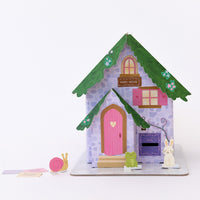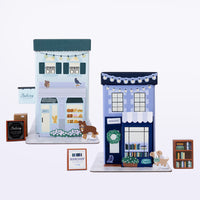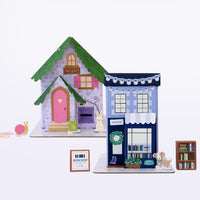
Understanding The Spectrum
As people, we all fall somewhere on the spectrum of human development. Neurodivergence is a non-medical term used to describe people whose mental or neurological function deviates from typical development. In the past, people may have used the words "normal" or "abnormal" to describe someone's development, but we know today that language plays a crucial role in inclusivity, which is why we use more appropriate terms to capture the wide array of development that humans experience. Using "person-first" language is one way to ensure that the whole person is being considered and that they are not defined by their disability.
Acceptance VS. Inclusion
People often refer to "acceptance" in society as if it is synonymous with inclusion. At Make It Cute, we realize that there is an essential difference between these two concepts. Acceptance implies that there is something that people must come to "accept" about another person. On the other hand, inclusion values differences among people. It encourages belonging not despite someone's differences but with respect and admiration for their differing experiences and the understanding that uniqueness makes our world special.
Playhouses & Inclusivity
At Make It Cute, we aim to make our products inclusive for as many children as possible. Our playhouses are designed to be versatile and were created with inclusivity in mind. The Cottage or the Modern Farmhouse is an excellent investment for families or school classrooms where kids of differing abilities explore, interact, and play together. We strive to create "entry points" that go beyond the physical entrances to the space and encompass the overall design, making it possible for children to enjoy our playhouses, regardless of where they are on the development spectrum.
We recently heard from a customer, Sara M., who thanked us for a terrific product and shared that her two almost 2-year-old grandchildren were captivated by their new playhouse! She said that one of her grandchildren, who has autism spectrum disorder, especially loved the playhouse and that "he's obsessed with doors, and the playhouse was a safe way for him to open and close to his heart's content."
For other children who may be affected by sensory processing disorders, the playhouse offers a calming space. It is intentionally designed with muted colors and limited distractions inside to support all children looking for a space to feel comfortable and decompress. The open-ended nature of our indoor playhouse allows for children who are not yet verbal a venue to practice their communication skills. In contrast, other children who are very verbal can use the same space to put on a performance or play with extended dialogue.
The versatility of our playhouses is crucial to us. We want all children to feel welcome and as many children as possible to engage in the indoor playhouses in a way that is comfortable for them. We've seen firsthand in schools the benefits of children with varying learning needs coming together to play and interact with our playhouse as the focal point and the positive impact it has on every child participating. Whether your child or the children in your lives are advanced, typically developing, or have diverse needs, our playhouses provide countless benefits for their growth and development.
A Parent's Perspective
We recently had the opportunity to chat with Athena, a mother of a child who is neurodiverse, about her experience and thoughts on inclusivity. We are excited to share our conversation with you.
Make It Cute: Can you please tell us a little about yourself and your family?
Athena: My family and I live in Newport, California. We have a toddler named Xander and a fur baby named Saint, who we adore; he is like our true firstborn. I am from Newport, and my husband Tom is from Northern California. Tom works in tech, and I work as a creative freelancer for wellness brands such as ILIA Beauty, UNI, and Kat Burki Skincare. I love what I do, and I love living in California in the sunshine near the ocean.
Make It Cute: What types of play environments or structures have been most engaging and inclusive for your child in your experience?
Athena: He really loves the swings at parks, whether it is sitting on his own in the little baby seat or sitting on our lap on the bigger swing. He likes it if someone supports him walking around the playground to play with objects like giant tic tac toe. He enjoys engaging in toys, such as placing rings on a stick or popping objects open and closed; he loves to discover something inside a box or try to put an item inside of something; it's a nice challenge for his brain. He loves singing, dancing, and music, so when my parents play him guitar, we put on dance music with disco lights. He loves Miss Rachel and doing sign language to her songs. He loves counting fingers and doing the ABCs in sign language. He enjoys reading on our laps before bed or naps, flipping the pages, pointing, and learning about objects on each page. He loves walking around in his gait trainer, opening doors, turning lights on and off, and exploring what's inside each cabinet, drawer, or refrigerator.
Make It Cute: Are there any specific challenges you've faced in finding suitable products or activities for your child?
Athena: I would say the hardest thing would be activities or toys that require him to sit, walk, stand or crawl. If we create obstacle courses on the ground for him to do therapy it's one thing, but if there is a certain toy that other kids his age like using like a scooter or little bicycle or electric car or running around a park alone climbing objects, I feel bad sometimes because he isn't able to engage in those activities as much.
Make It Cute: Can you recommend any resources or communities that have been helpful in discovering new activities or products for neurodiverse children?
Athena: We really love Beyond Blindness! Their therapists, programs, school and events are great. They go all out, and everyone is so supportive and caring. We also love The Gray Academy, which is a newer school for neuro-diverse children in Orange County. The school really supports them with the right therapies and positive people and interactions that actually can help them grow and learn and develop in their ways, instead of trying to make our kids fit into a box by going to a "normal" school where they don't provide as much support for their growth. The other parents here and the staff are so helpful and a great resource. I also have met parents through word of mouth who have become such support for me, so by just sharing my story with friends and family, I have connected with some amazing people and found support.
Make It Cute: What advice would you give to other parents looking to create an inclusive play environment for their children?
Athena: I think having an outdoor area or big area with floor space is super inclusive and important for us, whether that is outside in the grass on a big blanket or mat so our son can roll around and feel free and safe to move and explore. We have a big play mat indoors that's soft for him to move and practice sitting and crawling on to protect his head. We also made our upstairs deck into a big grassy floor space, and I got this waterproof blanket on Amazon so he can be outside in the sunshine, roll around, sit, and play safely.
Benefits of Inclusive Play
At Make It Cute, we love hearing directly from parents about their experiences caring for young children and their advice about ways to find support in their communities and honing in on what works for their individual children. One thing is clear: open-ended play areas are essential for all children to enjoy safe play.
Creating play areas with inclusion in mind, including open-ended spaces, can positively affect children's growth. Within these open-ended spaces, children can practice their communication skills, hone their social-emotional skills through mindfulness or by building empathy through play scenarios, and practice their fine motor skills while drawing, using play dough, or completing puzzles. Inclusive play provides opportunities for all kinds to practice critical thinking skills, learn about safety, and work on self-regulation skills. All children can benefit from these experiences.
As caregivers, we can encourage inclusive play by considering not only the physical space we provide for our children to play in but also the types of materials that are included there. Dolls and babies, soft building blocks, and playhouses are great starting points when designing your child's play space. All of these items can be used in many ways depending on the child playing with them.
Ideas to Promote Inclusivity
Keep in mind that we have an important role to play as parents. Children are like sponges. How you treat people, especially when they are new to you or have a noticeable difference, will trickle down to your child. Even if you are learning yourself, be a good example for your child by trying to take steps to be more inclusive for all.
Here are some ways that you can make a difference when it comes to being inclusive:
- Language Matters: Use "person first" language. For example, you would say "a child with autism" rather than "an autistic child." Be aware of inclusive ways to speak about someone. When appropriate, ask questions directly or to a caregiver to ensure you use appropriate language to refer to a person's disability.
- Take Caregiver Cues: Look to the caretaker, if there is one, to determine what type of interaction is welcome. You can take their lead in your interaction with someone if you're unsure how to approach them or what type of interaction is appropriate. Of course, remember their level of familiarity with the person and respect boundaries. Your interactions will be different based on your relationship with them.
- Speak without Expectation: Speaking to someone who may have a developmental disability is a common courtesy. Treat others how you would like to be treated. When you feel unsure of what to say, you can lean on rhetorical questions or statements that do not require a response (comment on the weather, compliment a person's shirt or shoes), but do not wait expectantly for a response. If there is no response to your attempt at communication/connection, a simple smile goes a long way.
- Welcome All Forms of Communication: Not every person is capable or interested in a verbal exchange with someone they've just met for the first time. On the contrary, some people may overshare or "over-communicate" at the first meeting. When interacting with someone who may have a disability, be sure to welcome all forms of communication, from non-verbal greetings, like a wave, to an attempt at talking to a lengthy, one-sided share. Respond with politeness: a nod of your head is an excellent way to go when you're trying to convey your interest in interacting with someone.
- Use Your Manners: Treat others how you would like to be treated. All humans are important. Greet people when appropriate, smile, and say "please" and "thank you." Hold doors and let someone go first when leaving or entering buildings or elevators. If you stick to the basics, you're on the right path toward inclusion.
- Think Bigger: You have a voice and a role in your community. Advocate for spaces to become more inclusive for people in your community. Make sure that playgrounds and public spaces are designed with all community members in mind and that they can not only access these places as an afterthought but are considered in societal spaces' design and planning process. This is not limited to physical spaces but also to community programs, such as the planning of classes and events, such as what books are represented in the library and government-disseminated materials. Representation matters. Seeing yourself and others represented regularly is a significant step toward being inclusive. Other things to consider are advocating for ways to make programs, like a book club or cooking class, more inclusive for all.
Make It Cute
We are proud to make products that can be enjoyed by as many kids and grown-ups as possible! Our playhouses are a great investment for those who are looking for a versatile option for children at multiple stages of development. They not only span a large age range of early childhood, as they are safety tested for children ages 2-6 but also lend themselves to open-ended play experiences that are as unique as the children who are engaging with them.
Connect With Us
Connect with Make It Cute on Instagram @makeitcutekids to learn more about our playhouses, the founders, and ways you can join us in making the world a more inclusive place for all!









